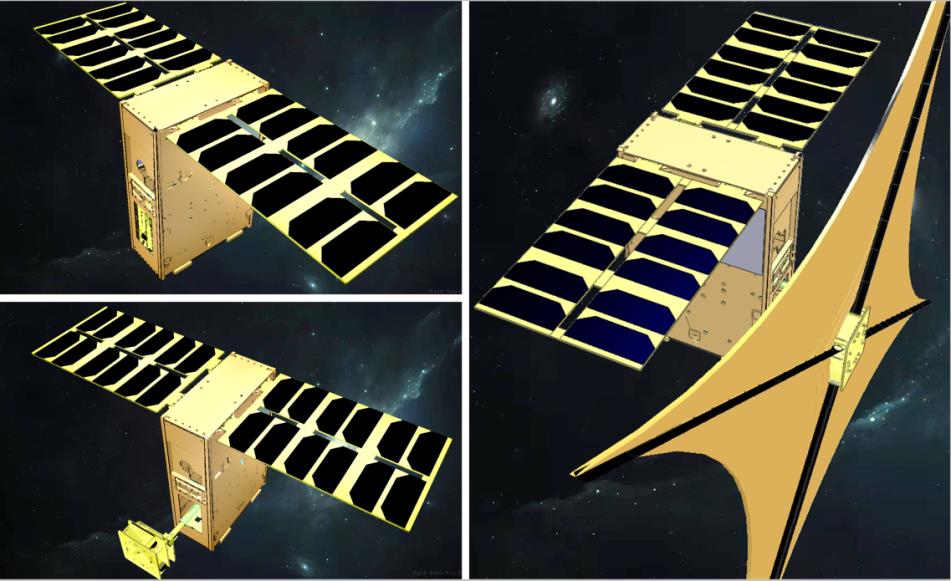That was 2010, 3 CZ-5DY. It is for the first phase of man on the moon. Since CZ-5DY is replaced by "921", IF they still plan a first phase, it will be 2 "921" instead because total LEO payload of 3 CZ-5DY is 150 tonne which is roughly translated to around LTO 50 tonne, the Apollo mass for 3 men, while two "921" can deliver LTO 55 tonne.A Chinese space scientist did elaborate on a way to go the moon using not one by 3 Long March 5 launches.
You are using an out of date browser. It may not display this or other websites correctly.
You should upgrade or use an alternative browser.
You should upgrade or use an alternative browser.
China's Space Program News Thread
- Thread starter crazyinsane105
- Start date
- Status
- Not open for further replies.
Equation
Lieutenant General
She is a beautiful BEAST!Five more high-resolution images.





antiterror13
Brigadier
Imagine the consequences of this baby regularly launch, let say 3-5 a year ... imagine how powerful the Chinese satellites would be.
Shijian-20 is already one of the best communication satellites out there
The highlights :
* Generates an output of 30 kW
* High-throughput communications payload of 70 Gbps.
* Optical infrared laser communications terminal for downlinks with data rates 4.8 Gbit/s
* Experimental quantum communications payload, similar to the one on QSS (Mozi)
* The satellite also has an ion engine for fine orbit corrections during its expected 20-year lifespan
* New higher-power ion thrusters
* Weighing in at over seven metric tons, Shijian-18 will be the heaviest Geostationary Satellite
Shijian-20 is already one of the best communication satellites out there
The highlights :
* Generates an output of 30 kW
* High-throughput communications payload of 70 Gbps.
* Optical infrared laser communications terminal for downlinks with data rates 4.8 Gbit/s
* Experimental quantum communications payload, similar to the one on QSS (Mozi)
* The satellite also has an ion engine for fine orbit corrections during its expected 20-year lifespan
* New higher-power ion thrusters
* Weighing in at over seven metric tons, Shijian-18 will be the heaviest Geostationary Satellite
Last edited:
antiterror13
Brigadier
Wondering whether there is any American components in the Shijian-20 
I am assuming Shijian-20 is 100% with Chinese components and software! ... any ideas?
I am assuming Shijian-20 is 100% with Chinese components and software! ... any ideas?

The Shenyang Institute of Automation (SIA) announced on Thursday that China's first solar sail, SIASAIL-I, has successfully verified a number of key technologies in orbit, a big breakthrough in China's solar sail development.
The solar sail developed by the institute of the Chinese Academy of Sciences based in Northeast China's Liaoning province is a spacecraft powered by the reflected light pressure of the sun on the spacecraft's membrane. Because it does not consume additional chemical fuel, a solar sail is considered to be the one and only spacecraft that may reach outside the solar system. It can be applied to a wide range of fields, including asteroid exploration, geomagnetic storm monitoring, solar polar exploration and space debris removal.
Phoenix_Rising
Junior Member
Wondering whether there is any American component in the Shijian-20
I am assuming Shijian-20 is 100% with Chinese components and software! ... any ideas?
A toast to Christopher and Frank! Chinese space agency should honor each of them a 1-tonne medallion.
Quickie
Colonel
Notice in all the CNSA released moon pictures how the color and texture of the lunar surface and the tracks of the rover always look different from those of the Apollo era.
In this picture, it even has a pinkish-brown tint at the center of the picture.
On Far Side of the Moon, Chinese Lander and Rover Hit One-Year Mark.

China's Yutu 2 rover leaves tracks on the far side of the moon. The rover and its Chang'e-4 lander hit the one-year mark on the moon on Jan. 3, 2020.
(Image: © CNSA)
China hit a historic milestone on the moon Friday (Jan. 3) as its Chang'e 4 lander and rover celebrated their first full year exploring the lunar far side.
The Chinese and its rover Yutu 2 officially completed their 13th lunar day on Thursday (Beijing time), . The pair has switched to a dormant mode to sleep through the lunar night, according to the Lunar Exploration and Space Program Center of the (CNSA).
and made the first-ever soft landing on the far side of the moon on Jan. 3, 2019. The spacecraft touched down in in the Von Kármán crater at the lunar South Pole-Aitken Basin, where they have been ever since.
A record-breaking moon rover
As of Friday, the Yutu 2 rover has driven 1,173 feet (357.695 meters) on the moon's far side, according to China's state-run Xinhua news service. Yutu-2 (it's name means Jade Rabbit-2) has worked much longer than its initial three-month design life, becoming the longest-working rover on the moon.
"The scientific instruments on the lander and rover worked as planned. The rover conducted explorations of several sites and photographed and conducted an infrared detection of a stone on the lunar surface, said the center," .
Chang'e-4 mission scientists have christened their landing site Statio Tianhe, Xinhua stated. "Tianhe" is Mandarin for the Milky Way and "Statio" is Latin for station.
China's Yutu 2 rover leaves tracks on the far side of the moon. The rover and its Chang'e-4 lander hit the one-year mark on the moon on Jan. 3, 2020. (Image credit: CNSA)
Chang'e-4's Yutu 2 rover has made several discoveries on the moon's farside. Among them, it found that the lunar regolith around the Chang'e-4 lander contains the minerals olivine and pyroxene, which came from deep inside the moon.
With Chang'e-4 on the far side of the moon, CNSA has been relying on a , which is stationed beyond the moon in a stable Lagrange point about 310,685 miles (500,000 kilometers) from Earth. Zhang Lihua, the satellite's chief designer, said it could last another 10 years, according to Xinhua.
"We will let the Queqiao work as long as possible. It could also provide communication for probes from other countries if they intend to explore the moon's far side within the lifetime of the satellite," Xinhua quoted Ye Peijian, a Chinese Academy of Sciences researcher and a senior space expert, as saying.
While the Chang'e-4 mission continues, China is looking ahead to its next lunar mission:
That new mission, which is expected to launch sometime in 2020, will launch another lander and rover to the moon on a mission to return lunar samples to Earth.
In this picture, it even has a pinkish-brown tint at the center of the picture.
On Far Side of the Moon, Chinese Lander and Rover Hit One-Year Mark.

China's Yutu 2 rover leaves tracks on the far side of the moon. The rover and its Chang'e-4 lander hit the one-year mark on the moon on Jan. 3, 2020.
(Image: © CNSA)
China hit a historic milestone on the moon Friday (Jan. 3) as its Chang'e 4 lander and rover celebrated their first full year exploring the lunar far side.
The Chinese and its rover Yutu 2 officially completed their 13th lunar day on Thursday (Beijing time), . The pair has switched to a dormant mode to sleep through the lunar night, according to the Lunar Exploration and Space Program Center of the (CNSA).
and made the first-ever soft landing on the far side of the moon on Jan. 3, 2019. The spacecraft touched down in in the Von Kármán crater at the lunar South Pole-Aitken Basin, where they have been ever since.
A record-breaking moon rover
As of Friday, the Yutu 2 rover has driven 1,173 feet (357.695 meters) on the moon's far side, according to China's state-run Xinhua news service. Yutu-2 (it's name means Jade Rabbit-2) has worked much longer than its initial three-month design life, becoming the longest-working rover on the moon.
"The scientific instruments on the lander and rover worked as planned. The rover conducted explorations of several sites and photographed and conducted an infrared detection of a stone on the lunar surface, said the center," .
Chang'e-4 mission scientists have christened their landing site Statio Tianhe, Xinhua stated. "Tianhe" is Mandarin for the Milky Way and "Statio" is Latin for station.
China's Yutu 2 rover leaves tracks on the far side of the moon. The rover and its Chang'e-4 lander hit the one-year mark on the moon on Jan. 3, 2020. (Image credit: CNSA)
Chang'e-4's Yutu 2 rover has made several discoveries on the moon's farside. Among them, it found that the lunar regolith around the Chang'e-4 lander contains the minerals olivine and pyroxene, which came from deep inside the moon.
With Chang'e-4 on the far side of the moon, CNSA has been relying on a , which is stationed beyond the moon in a stable Lagrange point about 310,685 miles (500,000 kilometers) from Earth. Zhang Lihua, the satellite's chief designer, said it could last another 10 years, according to Xinhua.
"We will let the Queqiao work as long as possible. It could also provide communication for probes from other countries if they intend to explore the moon's far side within the lifetime of the satellite," Xinhua quoted Ye Peijian, a Chinese Academy of Sciences researcher and a senior space expert, as saying.
While the Chang'e-4 mission continues, China is looking ahead to its next lunar mission:
That new mission, which is expected to launch sometime in 2020, will launch another lander and rover to the moon on a mission to return lunar samples to Earth.

After the successful return to flight of the powerful Long March 5 closing the orbital launch activities for China in 2019, the country launched another secretive Tongxin Jishu Shiyan Weixing (TJSW) satellite on January 7, opening what could be a record-breaking year. The launch took place at around 15:20 UTC using the Long March 3B/G2 (Y64) ‘Chang Zheng-3B/G2’ launch vehicle from the LC2 launch complex of the Xichang Satellite Launch Center.
- Status
- Not open for further replies.



